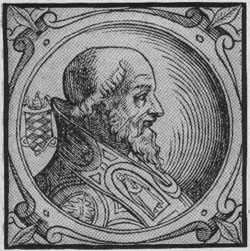
A favorite of Holy Roman Emperor Henry III, Victor was born Gebhard of Dollnsten-Hirschberg c. 1018 in Swabia. In 1042, he become the bishop of Eichstätt, and in the early 1050's, Henry appointed him chancellor. Victor, whom Henry nominated, was elected pope in 1055, and in the same year, Henry named him Duke of Spoleto and Count of Fermo. When Henry died the following year, Victor was given care of Henry's son, whom he crowned emperor with Queen Agnes as regent. Victor died in 1057.
Pope Victor II (c. 1018 – 28 July 1057), born Gebhard of Dollnstein-Hirschberg, was the head of the Catholic Church and ruler of the Papal States from 13 April 1055 until his death in 1057. Victor II was one of a series of German-born popes who led Gregorian Reform.
Early life
Gebhard was a native of the Kingdom of Germany in the Holy Roman Empire. He was a son of the Swabian Count Hartwig of Calw and a kinsman of Emperor Henry III. Hartweg's brother, Gotebold, had been a canon of Eichstatt, then Provost of Speyer, Imperial Chancellor for Italy, and, from 1049 to 1063, Patriarch of Aquileia. At the suggestion of the emperor's uncle, Gebhard, bishop of Ratisbon, the 24-year-old Gebhard was appointed bishop of Eichstätt. In this position, he supported the emperor's interests and eventually became one of his closest advisors.
Papacy
After the death of Pope Leo IX, a Roman delegation headed by Hildebrand, later Pope Gregory VII, travelled to Mainz and asked the emperor to nominate Gebhard as successor. At a court Diet held at Ratisbon in March, 1055, Gebhard accepted the papacy, provided that the emperor restore to the Apostolic See all the possessions that had been taken from it. When the emperor agreed, Gebhard, taking the name Victor II, moved to Rome and was enthroned in St. Peter's Basilica on 13 April 1055.
Victor excommunicated both Count Ramon Berenguer I of Barcelona and Countess Almodis of Limoges for adultery at the behest of Ermesinde of Carcassonne in 1055.
In June 1055, Victor met the emperor at Florence and held a council, which reinforced Pope Leo IX's condemnation of clerical marriage, simony, and the loss of the church's properties. In the following year, he was summoned to the emperor's side, and was with Henry III when he died at Bodfeld in the Harz on 5 October 1056. As guardian of Henry III's infant son Henry IV and adviser of Empress Agnes, Henry IV's mother, Victor wielded enormous power, which he used to maintain peace throughout the empire and to strengthen the papacy against the aggressions of the barons. During the rivalry between Archbishop Anno II of Cologne and other senior clergymen and the empress, Victor backed Agnes and her supporters. Many of her close followers would be promoted, men like Bishop Henry II of Augsburg, who would later become Emperor Henry's nominal regent, and several German princes were given high court and church offices.
At the beginning of Lent 1057, Victor and his court began their journey to Rome.
On 18 April 1057, Pope Victor held a general council in the Lateran Basilica. The diocese of the Marsi, which had been divided in two by Pope Benedict IX (Theophylact), was reunited into a single diocese. In the same council, the dispute concerning jurisdiction over a parish between the diocese of Siena and the diocese of Arezzo was heard for the first time. In May the pope began a trip to Tuscany. He spent eight days at Siena. The suit between the bishops of Siena and Arezzo resumed, and the pope took the trouble to visit the area of dispute, and talk to parishioners and local aristocracy. He then held a synod at the palace of S. Donato near Arezzo, and issued a bull, assigning the disputed parish to the diocese of Arezzo.
On 14 June 1057, Pope Victor appointed his chancellor, Frederick of Lorraine, to the position of cardinal-presbyter of San Crisogono. Cardinal Frederick took part in a synod at Arezzo on 23 July, and then was consecrated the thirty-sixth abbot of Montecassino by Pope Victor on 24 June 1057.
Death
Victor died shortly after his return to Italy, at Arezzo, on 28 July 1057. His death marked an end to the close relationship shared between the Salian dynasty and the papacy. Victor's retinue wished to bring his remains to the cathedral at Eichstätt for burial. Before they reached the city, however, the remains were seized by some citizens of Ravenna and buried there in the Church of Santa Maria Rotonda, the burial place of Theodoric the Great.

